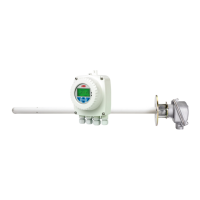What does CAL. FACTOR FAILED mean in ABB Measuring Instruments?
- KKaren WheelerSep 3, 2025
CAL. FACTOR FAILED in ABB Measuring Instruments indicates that the cell is faulty. Replace the cell.

What does CAL. FACTOR FAILED mean in ABB Measuring Instruments?
CAL. FACTOR FAILED in ABB Measuring Instruments indicates that the cell is faulty. Replace the cell.
What to do if CAL. OFFSET FAILED in ABB Endura AZ Measuring Instruments?
If CAL. OFFSET FAILED appears on your ABB Measuring Instruments, it means the cell is faulty and needs to be replaced.
How to fix CALIBRATION STABILITY FAILED error in ABB Measuring Instruments?
CALIBRATION STABILITY FAILED in ABB Measuring Instruments means the cell input measurement is too noisy. Check the gas connections and repeat the calibration.
Why did my ABB Endura AZ Measuring Instruments miss the scheduled autocal?
If your ABB Measuring Instruments missed the scheduled autocal, it's likely because the device wasn't in operating mode when the calibration was scheduled. Check why the automatic calibration wasn't performed and then perform a calibration.
What does MAINS FREQUENCY ERROR mean in ABB Measuring Instruments?
MAINS FREQUENCY ERROR in ABB Measuring Instruments means the power frequency is not within the 45 Hz to 65 Hz range. Check the power source.
What causes O2 SENSOR OUT OF RANGE error in ABB Endura AZ?
O2 SENSOR OUT OF RANGE in ABB Measuring Instruments means the process oxygen concentration is beyond the set operating range. Address the process issue or extend the oxygen operating range.
What does TEMP. SENSOR OUT OF RANGE mean on ABB Endura AZ Measuring Instruments?
TEMP. SENSOR OUT OF RANGE on ABB Measuring Instruments indicates that the maximum temperature range for the thermocouple has been exceeded. Check the operating conditions.
| Brand | ABB |
|---|---|
| Model | Endura AZ series |
| Category | Measuring Instruments |
| Language | English |
Guidelines for safe operation and handling of equipment.
Compliance with electrical safety standards and requirements.
General precautions to avoid injury or equipment damage during operation.
Definitions of warning and caution symbols used in the manual.
Key recommendations for safe operation and maintenance procedures.
Instructions for unpacking the transmitter and its components.
Guidelines for cleaning the transmitter, ensuring IP rating.
Specifies environmental and location requirements for transmitter installation.
Provides physical dimensions of the remote transmitter.
Critical safety information regarding electrical installation and grounding.
Steps for accessing the internal terminals of the remote transmitter.
Wiring details for connecting the AZ10 sensor to the remote transmitter.
How to connect power supply and output signals to the remote transmitter.
Wiring details for connecting the probe to the integral transmitter.
How to connect power supply and output signals to the integral transmitter.
How to navigate menus and parameters using the device keys.
Explanation of operator pages, menus, and icons.
Setting up passwords for different access levels.
Quick configuration of basic transmitter settings.
Procedures for sensor calibration and test gas setup.
Viewing diagnostic messages and historical data.
Settings for display mode, autoscroll, and screen contrast.
Configuring HART communication and data output.
Summary of available calibration types and their descriptions.
Step-by-step guide for performing system calibration routines.
Lists necessary hardware and software for HART communication.
Details on how to connect the transmitter for HART communication.
Information on device status bytes and error codes.
Explains diagnostic message icons and codes conforming to NAMUR NE107.
Details failure messages, possible causes, and corrective actions.
Lists messages indicating parameters outside specifications and solutions.
Lists maintenance-related messages and required actions.
Details on how Performance Log entries are displayed and their icons.
Overview of ABB Utility Software for PC communication.
Instructions for connecting the transmitter via the IrDA port.
Running the Remote HMI application for device control.
List of available documentation and software for the product.
Part numbers and descriptions for replacement transmitter components.
Specifications for measurement accuracy, range, and response time.
Operating and storage conditions, humidity, and sunlight requirements.
Specifications for the AC power supply and power consumption.
Types of transmitter enclosures and mounting options.
Details on AutoCal hardware and its functionality.
Specifications for standard and optional analog current outputs.
Details on digital I/O capabilities and functions.
Specifications for the IrDA port and its functions.
Manual and automatic calibration types and control methods.
